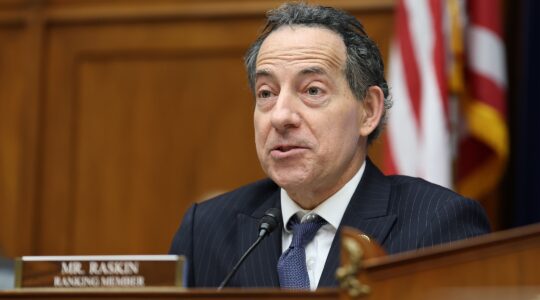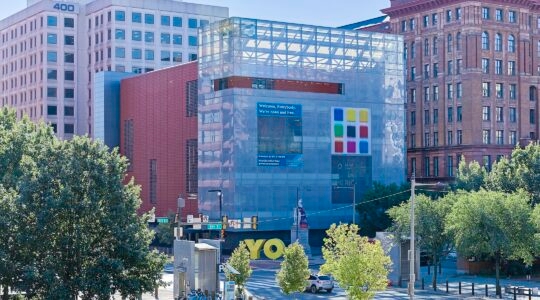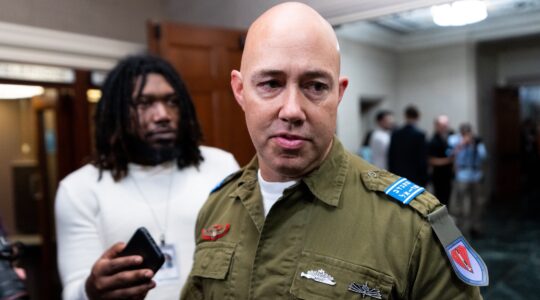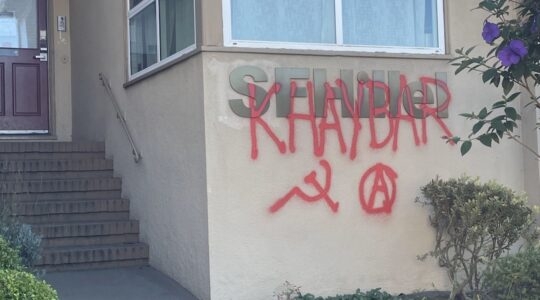
Can a Mexican poster artist living in East L.A., whose family owns panaderias (Mexican bakeries) and taquito stands, be a great branding artist for the Jewish people?
I’ve staked my professional reputation on it.
Alfonso Covarrubias, known in the L.A. design world as “Fons,” has created the visual of a new marketing campaign launched just before Passover by the Jewish Federation of Greater Los Angeles.
The design is just the first step of a launch that is building to a power-packed denouement on Yom Kippur. But the design is symbolic of what is to come over the next few months — a strategic campaign that breaks the traditional mold of Jewish and nonprofit marketing.
The months-long launch is reflective of what has been learned through observing innovations and the realities that surround us to today — the Obama election campaign, new media, social marketing, a new generation, the community service movement, the changing environment of Los Angeles, a dynamic and evolving Jewish world and the downward economic spiral.
In its break with tradition, it is indeed a campaign of risk — but a risk I believe must be taken today. My hope is that it will set the tone and the bar for the type of marketing thinking and risks the Jewish world must be taking to secure its vibrant future.
This month’s first step of the branding launch was designed with a sensibility that was to be both deeply Jewish and deeply L.A. The new branding tagline “GiveLifeMeaning.org” emerged from extensive conversations within the community, asking people what was their most powerful motivation for involvement and support. People mentioned a variety of reasons. Yet as we analyzed the responses, we understood that regardless of what they said, the issue of meaning was the one common denominator at the core of every response. It was a powerful denominator.
After creating the tagline, we were faced with what the visual appeal should be. Knowing we were all living in a city unlike anywhere else on earth, with a unique creative Jewish community unlike anywhere in the world, we knew that Los Angelesness had to be incorporated into all we did.
Los Angeles is now considered to be the most diverse city in the world. Living here, you can no longer move without confronting the fusion of cultures that greet you the second you leave your front door. And the predominant culture in L.A. and all of California is Latino. Today, L.A. is as much a city of Mexico and Central America as it is of Hollywood, Beverly Hills, the Westside and the Beach, where many Jews reside.
The most recent L.A. craze is the Korean Taco truck that blogs every weekend where it will be. Among its hundreds of online followers, lining up anywhere at any moment, are huge numbers of young Jews. I even recently met their lawyer — a young Persian Jewish activist. (Don’t ask me why the Korean Taco truck already needs a lawyer, but this is L.A.)
We knew that the branding had to take the L.A. fusion into consideration. Alfonso’s work was powerful and emotional. It was very L.A. When we met him, he had no pre-conceived judgments about a Jewish design and found the subject fascinating. We brought him to the library and pulled out Talmuds, illustrated Jewish books, photos of Eastern European Jewish objects, Sephardi ketubot and Israeli art, then left him for hours to consume the visuals. [[READMORE]]
After seeing all the design choices he eventually brought to us, I am convinced that sometimes we need to go outside to someone who knows nothing of who we are and can bring a fresh perspective. I am further convinced that fusing Jewish culture with what surrounds it makes for a stronger Jewish appeal.
Yet the biggest marketing mistake nonprofits make is when they believe branding is the main strategy or the only one. Marketing for nonprofits must go far beyond branding. It must move toward three results — funding, advocacy and involvement.
The second biggest mistake they make is thinking only in strategies and formulaic tactics and not in big breakthrough ideas. This campaign is being created through meeting both demands.
How the thinking for this marketing initiative began is as important a lesson as what emerged. There needed to be the right environment of risk-taking that would lead to a radical new marketing concept. That environment has been set at the L.A. federation by a brash and bold chairman, Stanley Gold, president of Shamrock Holdings. The federation executive, John Fishel, a believer in the importance of new media and the influence it will assert upon the future of nonprofits, was willing to support the idea in the face of economic stress and concerned budget committees.
The creative, critical thinking path for this level of idea cannot be done in an hour here and an hour there, between this task and that task, in the pressured way most federations work. It requires an unbroken chain of focus over several days, working in think-tank fashion to break with traditional methodologies.
In this case, four of us left the federation for two days, sat in an off-premise conference room, shut off our BlackBerries and worked 10-hour days. The four included Mitch Hamerman, the federation’s marketing director; Denise Osso, the creative director; Deborah Dragon, the public relations director; and myself. Denise, who is not Jewish, brought a perspective into the room that was not cynical about Jewish life, but one that was excited, in awe of who we are and embracing. It allowed us to see ourselves in a different way.
By the time we had met for those two days, the four of us already had held meetings with Obama strategists, reviewed campaigns for causes, had talked with viral professionals, been in countless strategic meetings with the fund-raising staff and laypeople, as well as the federation’s entertainment division and its Pathways (young professionals) groups.
During the first several hours, we established our guiding principles and basic assumptions:
1. The federation receives 25,000 gifts from 18,000 households. (Several households make double gifts.)
2. Los Angeles has 550,000 to 600,000 Jews living in 175,000 to 200,000 households. Our opportunity we realized was 157,000-plus households that we did not have.
3. In a downturn economy, we will lose a certain amount of gifts. But we recognized the huge pool that exists which could be a massive inflow if we did this right.
4. While the marketing campaign had to help retain and upgrade existing donors, it was imperative that it open the door to new donors and begin a cultivation process.
5. Many of those potential new donors already were in synagogues and other Jewish organizations, but the vast majority was not and those people were not necessarily open to traditional Jewish messages.
6. Obama’s campaign had proved you could raise money from the mass, who had been left out of most Jewish fund-raising strategies. L.A.’s mass was 600,000 Jews.
7. It also proved that a new generation is ready to step up to the plate.
8. It proved, too, that people will respond to causes, a movement, wanted and needed involvement, and if given the right circumstances, would donate online.
9. We realized that if we were to succeed with the mass and raise money, we would need to actively advocate for causes that could create change and involve people through volunteerism.
10. We would need to base our idea upon a community organizing initiative.
11. Our working objective in order to succeed at this task needed to be the gathering of hundreds of thousands of e-mails, so we could begin to identify who these Jews were and enter into some type of relationship with them.
12. We knew we needed a big idea; now we had a day and a half left to create it.
So we took a break and ate — Mexican food.
After lunch, the blend of our minds began to work and magic entered the room. We had not yet created the big idea, but we could sense we were on the path. We knew we were onto something big and different. We determined we would change the image of the organization to be seen as cause-oriented. What had been called the federation’s five pillars would now be called its five causes. We would amend the tired, over-spoken concept of tikkun olam and refresh it to be "The Movement to Repair the World," which would incorporate the five causes. But what would be the centerpiece of that movement?
Several months earlier, when it was apparent how serious the economic unraveling was, we had written the line that was now being used throughout the fund-raising campaign, “A Bad Economy Demands A Good Community.” We understood the promise of that line to be housing, jobs and food. As we talked about those promises, the big idea began to crystallize. The federation could not get into the housing business; it required professionals who knew the housing world. It could not get into the jobs business. That already was the domain of the Jewish Vocational Service. But it could get into the hunger business in a big way. Relieving hunger was a Jewish principle. The issue was being built every day in the press. The White House was planning its own hunger initiative. People would involve themselves in eradicating hunger.
The big idea was formed. The Jewish community would declare the goal of eradicating hunger among Jews in Los Angeles, as well as hunger among all people throughout Los Angeles County. We would work as an activist community toward this goal. With this message we could penetrate many of the households that we could not involve with other Jewish messages. It also was a message that could penetrate the Hollywood Jews, many who would also not respond to a traditional Jewish message. The Hollywood Jews are key to success in a city like Los Angeles. We could create a movement around hunger that would indeed need thousands of volunteers for both gathering and feeding, as well as political advocacy and activism.
We would make the synagogues the physical center of the movement, thereby creating a collaboration between federation and the synagogues that not only would be one of social action, but one that would drive Jews in the neighborhoods into their local synagogues. We would work in close collaboration with Mazon, the L.A.-based international Jewish response to hunger, and with SOVA and Tomchei Shabbas, the local Jewish hunger organizations. The movement would be multi-generational. We would work to create curriculum on the issues for the Jewish schools. The ideas and possibilities were endless.
In the end, we are hoping that through the hunger initiative we will attract thousands of Jews who will learn of the federation and its causes.
As we tell this idea to the leadership of the federation, to professionals, donors and community partners, the excitement is palpable. People who at first were skeptical are now bought in. The biggest controversy so far has been the sectarian/nonsectarian discussion. In an economic downturn, can we afford to set a goal this expansive? Shouldn’t we be realistic and just concern ourselves with Jewish hunger?
In response, remaining just in the realm of being marketing strategists, we remind them that without us targeting all of the people, the Jews we are trying to attract, especially the Hollywood Jews, will never buy in. These are people who have not responded to Jewish need alone — even many of the wealthy ones.
The challenges ahead of us are enormous. We must be ready to roll this out on Yom Kippur, the day when everyone is thinking about food. This is a big change in how the L.A. federation does business. Change is never easy. But now, it is paramount. The risk is worth taking.
(Gary Wexler is the owner of Passion Marketing, consulting with some of the largest nonprofits in the world, including many in Jewish life. He is a JTA board member.)

Help ensure Jewish news remains accessible to all. Your donation to the Jewish Telegraphic Agency powers the trusted journalism that has connected Jewish communities worldwide for more than 100 years. With your help, JTA can continue to deliver vital news and insights. Donate today.





